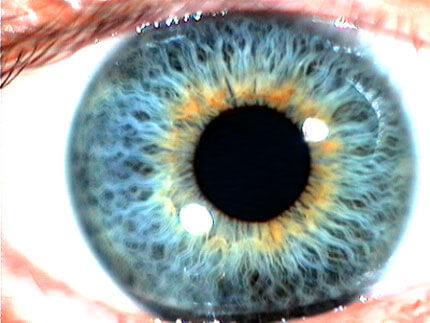547
What is behind the color of your eyes
Every person of sound mind and reason can answer the question, what color are his eyes. But if everyone is right? It's not about possible variations in the definition of blue-green speckled or gray-blue hue there, but it's a totally different approach.
What if the person can not suspect about this solid color, genetically inherent nature?
Perhaps not everyone will easily accept the news that iris may change during the life. Because we are so used to looking at his reflection in the mirror, that hardly have missed such detail.

However, not so clear. Iris pattern is a unique, individual code, inherent nature, like a fingerprint. The modern system of person authentication by chance includes the technology of biometric recognition by iris. The iris is formed before birth to end of life remains unchanged. It is impossible to find exactly the same figures even among twins.
As for eye color, then it's not a constant variable, and transforming. It is no secret that it can change throughout the life at least twice: at birth and with the onset of old age. In the vast majority of cases babies are born with blue eyes. Over time begins to produce melanin and, as a rule, for 3-4 years color already stabiliziruemost. Eyes either remain blue, or become brown, gray, green, etc. the opposite way the changes occur in the elderly, when the color pigment ceases to be produced in the proper amount. Dark eyes become bright, and the light darken. Also the color can be affected by the presence of certain eye diseases or serious medication.

And yet, perhaps, some color-shades, spots on the iris of the eye is not an innate data, acquired as a result of certain health problems. Such thoughts may come across some research from the field of medicine, namely iridology. Supporters of this research area are confident that we will be able to tell you much more about what is behind the color of your eyes.
The iridology is a method to diagnose various diseases of the iris of the eye. The theory is based on the fact that the eye has a huge number of nerve connections to internal organs. Any abnormality is immediately projected onto the iris of the eye.
The eye can be divided into multiple sectors, each responsible for a specific organ. While the envelope of the right eye corresponds to the right side of the body, and the left, respectively, for the left.
For clarity, here is a map of correspondences, quite easy to understand. So, if you try to correlate spots or blotches and the sector in which they are located, can detect the presence of a disease. Of course, science is much more complicated and deeper, but in General the method works something like this.
According to the theory, the true natural colors can only be brown and blue. Other colors, however beautiful they may be, is a sign of any health problems. Strange, isn't it? For example, the most common "acquired" a color pigment is formed around the pupil.
For this sector meets the large intestine, which speaks of slagging of the organism.
Iridology often also pay attention to the outer edge of the iris:
The density of the iris — another indicator of health. So, dense texture of the iris indicates a strong immunity and body resistance. If the iris is tears in the tissues and more rare or wavy distributed fibers, the body more susceptible to illnesses, both physically and emotionally.


Another frequent feature of the so — called ring voltage or nervous arc. These rings are formed around the periphery of the iris in the form of holes in its texture. As you might guess from the title, such education is a sign of exposure to extensive emotional strains and stresses.

Thus, it is logical to assume that if you rid the human changes the eye color. There are several testimonies. They mainly concern changes in connection with the transition to a different diet. For example, some hardcore supporters of raw foodism claim that after some time the color of their eyes really changed. This can be explained by consumption of large amounts of fiber, which the body naturally gets rid of toxins and toxins.


Also interesting: the Psychological causes of visual impairment
How to save eyes from glasses by using 1 simple tool
The main argument against of iridology is that the method works not very accurately, and match in the correct diagnosis is not more than the usual accident. Themselves proponents of the theory often only encouraged to pay attention to the direct correlation of organs with iris as an opportunity to observe the approach of the disease in time. And accurate analyses — the case of modern medicine.
And it is hardly lost on the ground, you will try to navigate by the stars when there's Navigator. Right? So this method allows you to pay attention to many problems that could be ignored at an early stage.published
Author: Ekaterina Vitkovskaia
Source: www.cablook.com/mixlook/est-li-pravda-v-glazah/
What if the person can not suspect about this solid color, genetically inherent nature?
Perhaps not everyone will easily accept the news that iris may change during the life. Because we are so used to looking at his reflection in the mirror, that hardly have missed such detail.

However, not so clear. Iris pattern is a unique, individual code, inherent nature, like a fingerprint. The modern system of person authentication by chance includes the technology of biometric recognition by iris. The iris is formed before birth to end of life remains unchanged. It is impossible to find exactly the same figures even among twins.
As for eye color, then it's not a constant variable, and transforming. It is no secret that it can change throughout the life at least twice: at birth and with the onset of old age. In the vast majority of cases babies are born with blue eyes. Over time begins to produce melanin and, as a rule, for 3-4 years color already stabiliziruemost. Eyes either remain blue, or become brown, gray, green, etc. the opposite way the changes occur in the elderly, when the color pigment ceases to be produced in the proper amount. Dark eyes become bright, and the light darken. Also the color can be affected by the presence of certain eye diseases or serious medication.

And yet, perhaps, some color-shades, spots on the iris of the eye is not an innate data, acquired as a result of certain health problems. Such thoughts may come across some research from the field of medicine, namely iridology. Supporters of this research area are confident that we will be able to tell you much more about what is behind the color of your eyes.
The iridology is a method to diagnose various diseases of the iris of the eye. The theory is based on the fact that the eye has a huge number of nerve connections to internal organs. Any abnormality is immediately projected onto the iris of the eye.
The eye can be divided into multiple sectors, each responsible for a specific organ. While the envelope of the right eye corresponds to the right side of the body, and the left, respectively, for the left.
For clarity, here is a map of correspondences, quite easy to understand. So, if you try to correlate spots or blotches and the sector in which they are located, can detect the presence of a disease. Of course, science is much more complicated and deeper, but in General the method works something like this.
According to the theory, the true natural colors can only be brown and blue. Other colors, however beautiful they may be, is a sign of any health problems. Strange, isn't it? For example, the most common "acquired" a color pigment is formed around the pupil.
For this sector meets the large intestine, which speaks of slagging of the organism.
Iridology often also pay attention to the outer edge of the iris:
- if the circle reaches a dark rim, this can indicate a disruption of the hemopoietic system, eczema, psoriasis, dermatitis;
- white rim is a sign of high cholesterol levels.
The density of the iris — another indicator of health. So, dense texture of the iris indicates a strong immunity and body resistance. If the iris is tears in the tissues and more rare or wavy distributed fibers, the body more susceptible to illnesses, both physically and emotionally.


Another frequent feature of the so — called ring voltage or nervous arc. These rings are formed around the periphery of the iris in the form of holes in its texture. As you might guess from the title, such education is a sign of exposure to extensive emotional strains and stresses.

Thus, it is logical to assume that if you rid the human changes the eye color. There are several testimonies. They mainly concern changes in connection with the transition to a different diet. For example, some hardcore supporters of raw foodism claim that after some time the color of their eyes really changed. This can be explained by consumption of large amounts of fiber, which the body naturally gets rid of toxins and toxins.


Also interesting: the Psychological causes of visual impairment
How to save eyes from glasses by using 1 simple tool
The main argument against of iridology is that the method works not very accurately, and match in the correct diagnosis is not more than the usual accident. Themselves proponents of the theory often only encouraged to pay attention to the direct correlation of organs with iris as an opportunity to observe the approach of the disease in time. And accurate analyses — the case of modern medicine.
And it is hardly lost on the ground, you will try to navigate by the stars when there's Navigator. Right? So this method allows you to pay attention to many problems that could be ignored at an early stage.published
Author: Ekaterina Vitkovskaia
Source: www.cablook.com/mixlook/est-li-pravda-v-glazah/






















